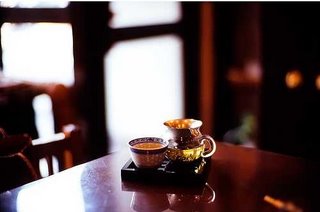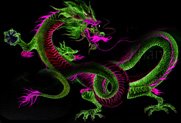Drinking Tea in Chinese Style - Chinese Tea Ceremony
 The art of drinking and serving tea plays a major cultural role in China. It inspires poetry and songs. Mutual love of tea cements lifelong friendships.
The art of drinking and serving tea plays a major cultural role in China. It inspires poetry and songs. Mutual love of tea cements lifelong friendships.For centuries, the ritual of preparing and serving tea has held a special place in the hearts and minds of Chinese aristocracy, court officials, intellectuals and poets.
The Chinese tea ceremony emphasizes the tea, rather than the ceremony -- what the tea tastes like, smells like, and how one tea tastes compared to the previous tea, or in successive rounds of drinking.
Ceremony doesn't mean that each server will perform the ritual the same way; it is not related to religion. Each step is meant to be a sensory exploration and appreciation.
Most teas used in the Chinese tea ceremony are grown in the mountains of Taiwan at around 4,000 feet. These teas are particularly refined, such as oolong teas which are lightly fermented and red teas that can be moderately to heavily fermented.
This style of tea-drinking uses small cups to match the small, unglazed clay teapots; each cup is just large enough to hold about two small swallows of tea. These tiny cups are particularly popular in Fujian and Chiujao, in southern coastal China above Canton. In Shanghai and Beijing they use large cups.
To Brew Tea Chinese-style Chinese Tea Ware.
 After heating water to boiling, the teapot first is rinsed with hot water. Using chopsticks or a bamboo tea scoop, fill teapot approximately 1/3 full with tea leaves and then pour boiling water into the pot.
After heating water to boiling, the teapot first is rinsed with hot water. Using chopsticks or a bamboo tea scoop, fill teapot approximately 1/3 full with tea leaves and then pour boiling water into the pot.Hold the teapot over a large bowl, letting the overflow run into the bowl.
Give the tea leaves a rinse by filling the pot half full with hot water, then draining the water out immediately, leaving only the soaked tea leaves.
Now fill the pot to the top with more hot water, cover and pour additional water over the teapot resting in the tea bowl. Do not allow bubbles to form in the pot.
When mixed with the tea, bubbles form a foam that is not aesthetically pleasing. Be sure to not let the tea steep too long; the first infusion should be steeped for only 30 seconds.
In less than a minute, pour the tea into the cups by moving the teapot around in a continual motion over the cups so that they are filled together. Each cup should taste exactly the same.
After steeping, the tea can be poured into a second teapot or tea pitcher to be served at leisure. More water can be added to the teapot, and up to five infusions typically can be made from the same tea leaves. Be sure to add 10 more seconds for the second brewing and 15 additional seconds thereafter.
 Each pot of tea serves three to four rounds and up to five or six, depending on the tea and the server. The goal is that each round taste the same as the first. Creating consistent flavor is where the mastery of the server is seen.
Each pot of tea serves three to four rounds and up to five or six, depending on the tea and the server. The goal is that each round taste the same as the first. Creating consistent flavor is where the mastery of the server is seen.Importance of Water
The water used in the tea ceremony is as important as the tea itself. Chlorine and fluoride in tap water should be filtered out as they harm the flavor of the tea. Distilled water makes flat tea and should be avoided.
High mineral content in the water brings out the richness and sweetness of green tea. Black teas taste better when made with water containing less Volvic.
Ideal tea water should have an alkaline pH around 7.9.
Green teas are ruined by boiling water; the temperature is best around 170-185 degrees F.
Oolongs made with underboiled water are more fragrant, which enhances the tea-drinking experience.
Info:holymtn.com





























0 Comments:
Post a Comment
<< Home